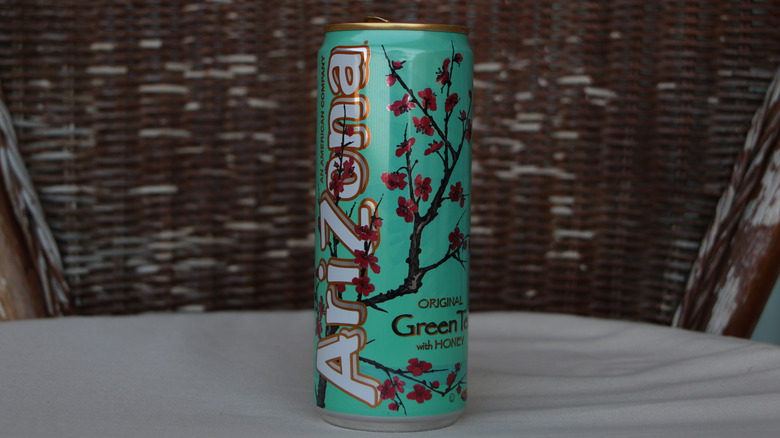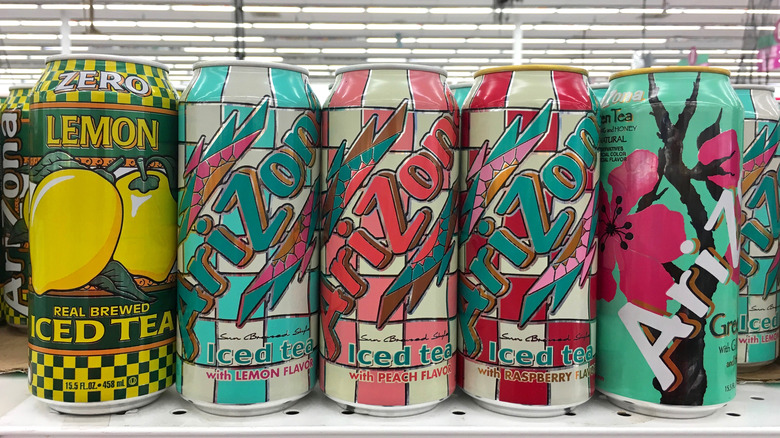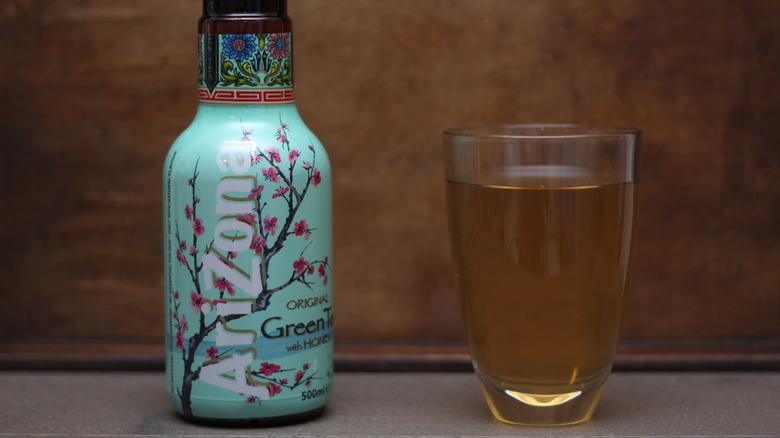Why Does Arizona Iced Tea Come So Cheap?
Finding a drink that's both delicious and affordable at the grocery store can sometimes feel impossible nowadays, but one of the few food and drink brands unchanged by inflation is AriZona Beverages. Despite pressure from outside forces, the popular drink brand has reliably stuck to its unprecedented 99-cent price. Even as the costs of our groceries, gas, and rent rise, the price of those tall cans of sweet teas and fruit juices remain the same.
While the prices of the ingredients used in AriZona Iced Tea have increased, from the aluminum of its cans to the cost of sugar, the brand hasn't deviated from its ultra-low prices. The beverages have cost 99 cents since the brand's resurrection, and 30 years later, it still shows no signs of changing. Inflation aside, 99 cents for a 23-ounce can of tea feels like a huge bargain, and the tasty drink remains one of the absolute cheapest options on the shelf. (Not to mention one of the largest.) So if you're just as curious as we are, here's why those iconic AriZona Iced Teas come so cheap.
How AriZona's low prices came to be
AriZona Beverages remains one of the few successful private brands in the drink market coming up against the likes of mega-giant producers like Pepsi and Coca-Cola. So how has the company survived in such a competitive market? Much of the credit is due to founder Don Vultaggio. The Brooklyn native was originally a brewer of malt liquor but decided to take the leap into the ready-to-drink tea market in 1991. The catalyst was when he saw full pallets of Snapple Iced Tea being unloaded off a delivery truck in the middle of winter. This was a business that could succeed year-round.
To give himself an edge over competitors, Vultaggio opted to make his cans bigger and bolder than other brands but still sold them at the same low price. Because the bright can was different than anything else on the shelves, and the prices were low, AriZona Iced Teas quickly became a hit after their debut in 1992.
The first AriZona teas on the shelves were lemon and raspberry with the most popular AriZona flavor, green tea with ginseng and honey, not coming until 1996. Since that time, AriZona also started printing its 99-cent price directly on cans so retailers and grocery stores wouldn't mark it up. From that very beginning, AriZona has been steadfast about its drink's low price.
How the company has maintained its low price
At the time of AriZona's founding, Snapple also retailed its teas for just 99 cents. Thirty years later, Snapple's teas are now retailing for $1.79, but AriZona continues selling at only 99 cents. So how do they do it? By completely cutting out one big area of business: marketing. "Our marketing plan is to make it look good, make it taste good and price it fair," Vultaggio shared with Forbes. Instead of rolling out huge advertisements, AriZona Beverages relies exclusively on word of mouth. (Which is the same reason why stores like Trader Joe's are so cheap). A lack of marketing is also why the AriZona can is made to be so tall and bright–it entices customers just like a billboard.
As for the continued low prices despite inflation, AriZona is simply eating the extra costs and accepting that they'll be making less money for the time being. As founder Don Vultaggio shared with Los Angeles Times, "I'm committed to that 99-cent price — when things go against you, you tighten your belt." The brand sells almost one billion cans every year, so it's clear people love the stuff. Either way, someone's gonna lose out. To Vultaggio, losing a loyal customer base for just a few extra bucks simply isn't justifiable.
AriZona has had to get creative to stay profitable
The company has found other ways to save money as costs have risen, too. Marketing is the biggest one — when you don't need to advertise, you can save some serious amounts of scratch — but its dedication to that low price point means it has had to get creative in other ways, too. The company's determination not to pass the current financial climate on to the customer extends surprisingly far. It doesn't seem to be doing it by cutting the workforce, either, as the savings appear to be coming from the production side. AriZona uses 40% less aluminum in its cans than it used to, uses its own factory to lower production costs, and even keeps gas costs down by doing nighttime deliveries to avoid traffic.
Thanks to all of these changes, AriZona is still making money — just not as much as it once was. Still, it's nice to see at least one company that's not so obsessed with exponential growth that it considers steady profits a failure. Vultaggio is right that the customer loyalty that engenders is something money can't buy.



